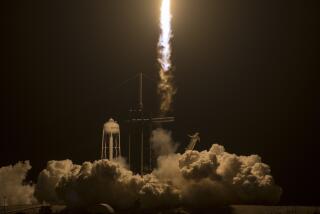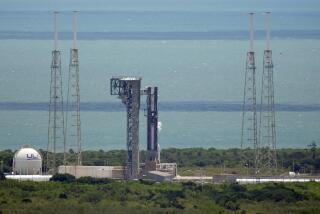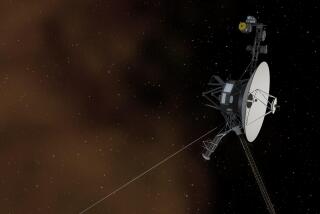Minor Trouble Briefly Hampers Satellite Released by Space Shuttle
- Share via
KENNEDY SPACE CENTER, Fla. — A gleaming, triangular satellite released by the crew of the space shuttle Atlantis on Friday sped around Earth sampling ozone and other atmospheric gases after ground controllers corrected its aim.
The German satellite barely had begun observations when sunlight blinded a navigation unit on the craft, causing a telescope cover to slam shut. At the same time, the unit could not lock onto stars to point the spacecraft’s telescopes because its field of view was too narrow.
The trouble occurred when Atlantis and the satellite were out of radio contact, and about 17 miles apart, said mission manager Konrad Moritz. The two spacecraft are routinely out of contact for hours at a time.
As soon as Atlantis and the satellite were back in contact, ground controllers sent up new pointing commands. It worked: The telescope door quickly reopened and observations resumed.
About two hours of data were lost.
One of the seven atmospheric and solar-energy monitors aboard Atlantis also ran into trouble--the data link between a German ozone monitor and ground controllers was lost Friday.
The U.S. and European monitors began observations Thursday evening, just hours after Atlantis lifted off.
The satellite release--one of the crew’s primary jobs in orbit--went perfectly.
French astronaut Jean-Francois Clervoy unlatched the satellite from the end of Atlantis’ robot arm as the shuttle soared 190 miles above northern Europe. Then commander Donald McMonagle slowly backed the shuttle away.
Clervoy released the 7,500-pound satellite so gently that German ground controllers didn’t detect any spin by the satellite and nervously called Mission Control to find out what was wrong. They were assured all was well.
Researchers are controlling the satellite from the Kennedy Space Center during its eight days of free flight. The six-member crew will retrieve the satellite next Saturday for the trip home.
Following the two-hour interruption, the infrared telescopes on the satellite continued measuring up to 14 atmospheric gases per second, in three directions at once. Scientists hope to analyze these gases and their chemical reactions between seven miles and 70 miles high.
The $35-million satellite also holds an ultraviolet instrument to measure atmospheric gases responsible for ozone damage. Robert Conway, a scientist at the Naval Research Laboratory in Washington, was ecstatic with the early data. He began working on the instrument in 1985.
“It’s been a long time, and I’m very excited,” Conway said. “It looks fabulous.”
More to Read
Sign up for Essential California
The most important California stories and recommendations in your inbox every morning.
You may occasionally receive promotional content from the Los Angeles Times.










